.Welcome to our comprehensive guide on What is SEO. In this article, we’ll go through the fundamentals of SEO, its importance for online visibility, and various techniques to improve your website’s search engine ranking.
“Have you ever wondered how certain websites magically appear at the top of your search results? In today’s digital age, mastering the art of SEO, or Search Engine Optimization, is the key to unlocking online success.”
SEO, or Search Engine Optimization, is the process of improving a website’s visibility and ranking on search engine results pages (SERPs).
Read the article fully if you are a beginner to understand deeply.
Search Engine Optimization
Understanding the basic of SEO is very important, because the foundation of SEO never change. So, here is the full guide of SEO to rank high in search engine result pages (SERPs).
SEO, or Search Engine Optimization, is the practice of optimizing a website to rank higher in search engine results pages (SERPs).
SEO is vital for improving website visibility and attracting organic traffic. It enhances user experience, credibility, and conversions, driving business growth in the competitive online environment.
Implementing SEO involves several steps:
-
- Conduct keyword research to identify relevant terms.
-
- Optimize on-page content with targeted keywords.
-
- Create high-quality, valuable content that satisfies user intent.
-
- Built quality backlinks from authoritative websites.
-
- Optimize technical aspects like site speed and mobile-friendliness.
-
- Regularly monitor performance and make adjustments based on analytics data.
-
- There are two types of SEO: black hat and white hat SEO. They both can bring results. But black hat cause a penalty by Google.
-
- Google algorithm is a complex set of rules and calculations used to determine the relevance and ranking of web pages in search results, constantly delivering the most accurate and valuable information to users.
-
- Google E-A-T key factors Google considers when evaluating website quality and content credibility.
What is SEO? Defination, Examples
SEO (Search Engine Optimization) is the process of optimizing your website and content to improve its visibility and ranking on search engine results pages (SERPs). It involves various strategies such as keyword research, on-page optimization, link building, and technical optimization to attract organic (non-paid) traffic from search engines like Google.
On the other hand, PPC (Pay-Per-Click) is a form of online advertising where advertisers pay a fee each time their ad is clicked. PPC allows advertisers to bid on keywords and display ads at the top of search results or on other websites, reaching potential customers quickly.
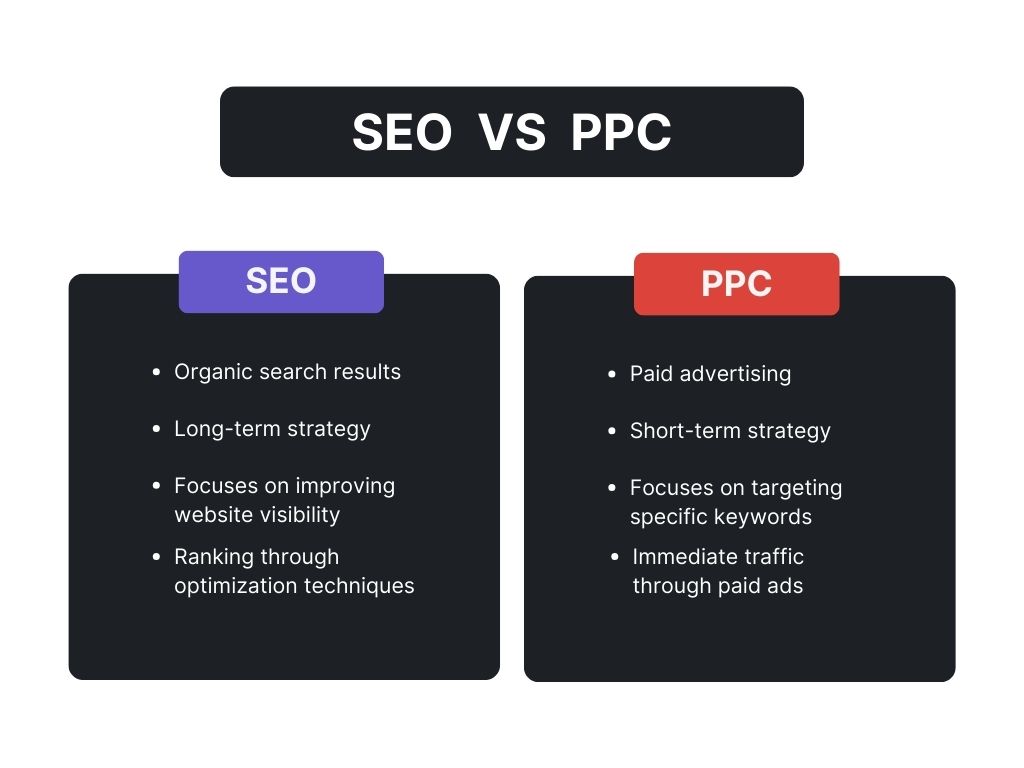
The main difference between SEO and PPC is that SEO is focused on improving organic search visibility over time, while PPC offers immediate visibility through paid advertising. SEO is a long-term strategy that requires ongoing effort and patience to see results, whereas PPC provides instant visibility but requires a budget to sustain campaigns.
Core elements of SEO:
In this comprehensive guide, we dig into these fundamental aspects, providing insights, strategies, and techniques to boost online presence effectively.
On-Page SEO:
On-page SEO refers to optimizing elements directly on a webpage to improve its search engine visibility. It contain various strategies aimed at enhancing the content, HTML source code, and overall user experience on a webpage.
Core component:
- Keyword Research
- Meta tags (Title tag, meta description, header)
- High quality content creation
- URL structure optimization
- Internal linking
- Mobile responsiveness and page speed
Off-Page SEO:
Off-page optimization involves activities conducted outside the boundaries of the website to enhance its authority, relevance, and trustworthiness in the eyes of search engines. This element of SEO emphasizes building quality backlinks and establishing a strong online presence across various platforms.
Core component:
- Link building (Guest blogging, Article, Social bookmarking)
- Social media engagement and promotions
- Influencer marketing and outreach
- Online reputation management
Technical SEO:
Technical optimization focuses on improving the technical aspects of a website to enhance its accessibility, crawlability, and indexability by search engine crawlers. It involves addressing underlying technical issues that may slow down a website’s performance in search results, thus ensuring a seamless user experience and better search engine visibility.
Core component:
- Website Structure and Navigation Optimization
- XML Sitemap Configuration and Submission
- Robots.txt Optimization
- Canonicalization and Redirect Management
- Schema Markup Implementation
- Website Security and HTTPS Protocol Adoption
- Mobile-Friendliness and Responsive Design
Before We Start Why is SEO important, We need to understand How Search Engines Work?
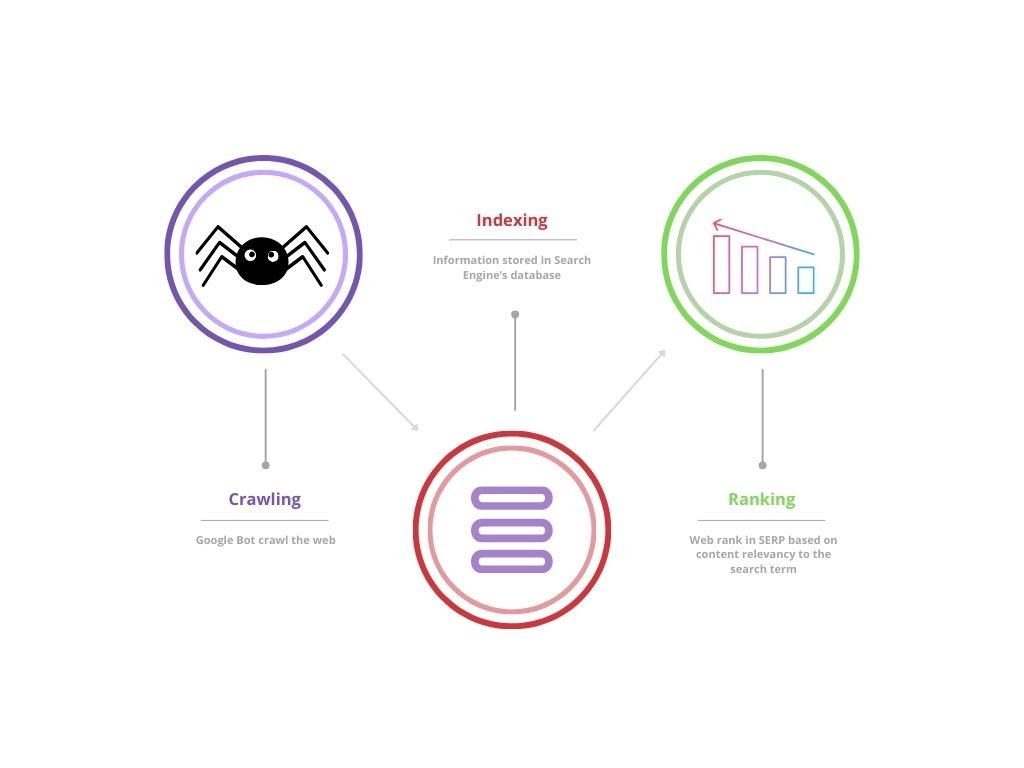
Search engines work by crawling, indexing, and ranking web pages to provide relevant results to users’ queries. Here’s a detailed breakdown:
Crawling: Search engine bots (also known as crawlers or spiders) navigate the web by following links from one webpage to another. They discover new pages and revisit existing ones to collect information.
Indexing: Once crawled, web pages are indexed, meaning they are stored in a vast database organized by content and relevance. Indexing involves analyzing and categorizing the content of each page based on keywords, metadata, and other factors.
Ranking: When users search, the engine retrieves pages from its index, ranks them based on relevance, authority, and user experience, and displays results accordingly on SERPs
Retrieval: Search engine displays ranked results on SERPs, with the most relevant pages at the top. Users click results to access desired information.
Overall, search engines aim to provide users with the most accurate, trustworthy, and useful information in response to their queries, continually refining their algorithms and processes to improve search quality and relevance.
Why is SEO important?
Firstly, SEO helps your website rank higher in search engine results pages (SERPs), making it more visible to potential customers.
By optimizing your content and website structure, you ensure that your target audience can easily find you when they search for relevant keywords or phrases.
Moreover, SEO boosts organic traffic, meaning more visitors come to your website without you having to pay for advertising. SEO builds trust and credibility with your audience.
When your website ranks highly in search results, users perceive it as more authoritative and trustworthy. This credibility encourages them to engage with your content, ultimately leading to increased conversions and sales.
Structure of Content
We all know that “Content is the king”
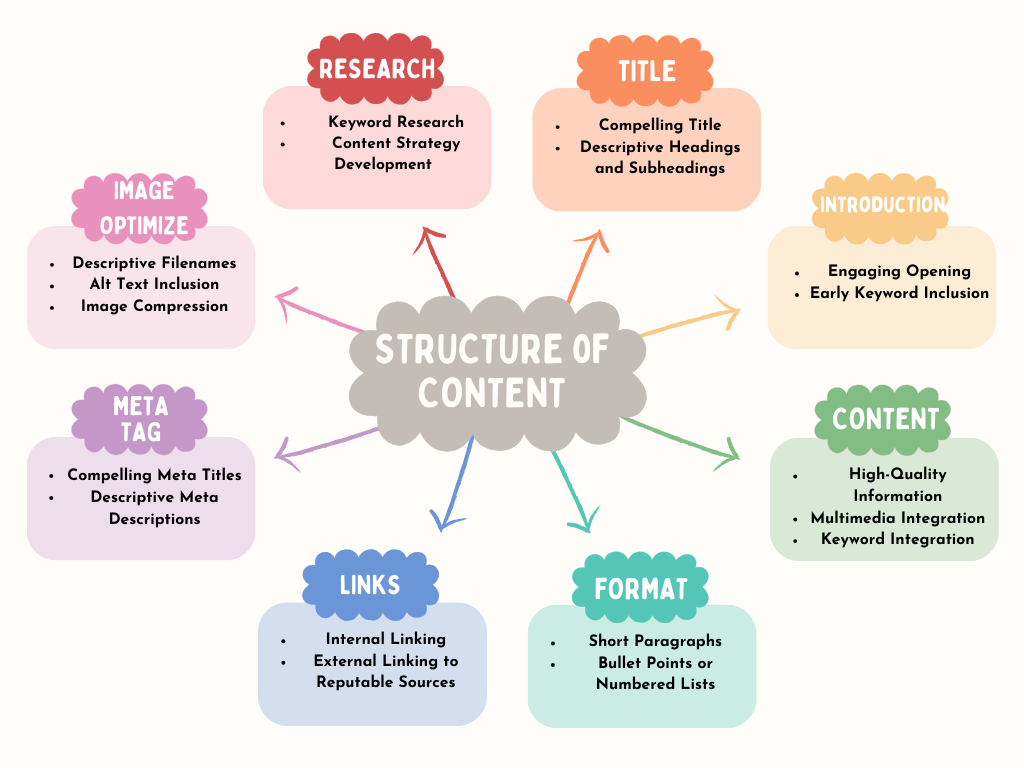
When crafting content, it’s essential to follow a structured approach to ensure clarity and coherence. Creating high-quality content is essential for driving traffic, engaging users, and achieving your marketing goals.
Understanding your Audience: Before creating content, it’s crucial to understand your target audience’s demographics, interests, and pain points.
Conduct audience research to gain insights into their needs and behaviors, which will help you tailor your content to resonate with them.
Keyword Research: Perform keyword research to find relevant search terms. Use tools like Google Keyword Planner, SEMrush, or Ahrefs to discover high-volume, low-competition keywords. Strategically include these keywords in your content to boost visibility and SERPs ranking.
Define your Goals: Determine the purpose and goals of your content. Are you trying to educate, entertain, inspire, or persuade your audience?
Are you aiming to drive traffic, generate leads, increase brand awareness, or boost sales? Clearly define your objectives to guide your content creation strategy.
Choose the Right Format: Consider the most appropriate format for your content based on your audience’s preferences and the nature of your topic. This could include blog posts, articles, infographics, videos, podcasts, case studies.
Create Compelling Headlines: Craft attention-grabbing headlines that accurately summarize the content of your piece and entice readers to click and engage.
Use powerful words, numbers, questions, to bring curiosity and encourage readers to explore deeper into your content.
Provide Value: Provide valuable insights, solutions, & entertainment. Address audience pain points, answer questions, or offer actionable advice. Focus on quality content that adds value & builds trust.
Use Engaging Visuals: Incorporate relevant images, graphics, videos, or infographics to enhance the visual appeal and readability of your content.
Maintain Consistency: Maintain a consistent tone, style, and brand voice across all your content to reinforce your brand identity and create a cohesive user experience.
Html
HTML, or Hypertext Markup Language, serves as the foundation of web pages, providing structure and formatting instructions for browsers to interpret and display content effectively. Lets’s explore the key elements that impact SEO:
-
- URL slug
-
- Title tag
-
- Meta description
-
- Alt txt
-
- Schema markup
-
- Robot.txt
-
- Canonical tag
URL Slug:
In SEO, a URL slug is the part of a URL that identifies a specific page or content. It’s important because it provides context and relevance to search engines and users.

URL slugs should be descriptive, concise, and contain relevant keywords to improve visibility and ranking in search results. They also enhance the user experience by making it easier to understand the content of the page before clicking.
Title Tag:
A title tag is an HTML element that specifies the title of a web page. It appears in the browser’s title bar and is displayed as the clickable headline in search engine results pages (SERPs).

Title tags are important for SEO because they provide context to search engines and users about the content of the page. Optimizing title tags can improve a page’s visibility and ranking in search results.
Meta Description:
A meta description is an HTML attribute that provides a summary of the content of a web page. It appears below the title tag in search engine results pages (SERPs) and provides users with additional information about the page’s content.

Meta descriptions are important for SEO because they can influence a user’s decision to click on a search result. They should be no longer than 160 characters.
Subheading:
Subheadings in SEO refer to the headings or titles used to break down content into smaller sections or subsections. They are typically formatted using HTML heading tags such as <h2>, <h3>, <h4>, etc.
4 tips for optimizing subheading
-
- Organizing Content: Subheadings help organize content into logical sections, making it easier for readers to navigate and understand.
-
- Enhancing Readability: By breaking up large blocks of text, subheadings improve readability and user experience, especially for online readers who tend to skim content.
-
- Improving SEO: Search engines use subheadings to understand the structure and hierarchy of a webpage’s content. Including relevant keywords in subheadings can help search engines better understand the topic and context of the content, potentially improving its visibility in search results.
-
- Highlighting Key Points: Subheadings can be used to highlight key points, ideas, or sections within the content, making them stand out to readers and search engines alike.
Alternative text:
Alt text, short for “alternative text,” is a brief description of an image within the HTML code of a webpage.
It’s important for SEO because search engines cannot “see” images like humans can, so they rely on alt text to understand what an image is about. By providing descriptive alt text, you help search engines understand the content and context of your images, which can improve your website’s accessibility and overall SEO performance.
Schema Markup:
Schema markup, also known as structured data, is code added to a website’s HTML to give search engines more information about the content. It uses standardized tags to describe different types of content like products or events.
One example of featured snippet schema:

Adding schema markup can enhance search results with extra details, like star ratings or prices, improving visibility and user experience. It’s important for SEO because it helps search engines understand content better, leading to higher visibility and click-through rates.
Use Schema on your website with the help of Google Structured Data Markup Helper or there are many other platforms you can use.
Important Things to know about Crawl Budget
Crawl Budget– Crawl budget is the no of pages Google bot crawls and indexes on the website within a given time frame
-
- Crawl budget is the level of attention your website gets from a crawler or search engine
-
- Higher authority websites may get a high crawl budget
How crawl budget assigned?
-
- Crawl limit/host load- how many URLs Google can crawl parallel
-
- Crawl demand/ crawl scheduling- Which URL is worth crawling most, based on its popularity and how often it is being updated?
How to optimize for Crawl Budget-
-
- URLs with parameters can create problems like abc.com/a/?search=” ->
Ignore param using robots.txt
-
- Broken links are dead ends
-
- More redirection can create a problem
-
- Content should be crawling-friendly – HTML
-
- Hosting/server is poor
-
- Structure and the hierarchy of the website. Make some imp pages higher in the hierarchy
Naked links– A link without anchor text. In the naked links, the link itself acts as anchor text hence there is no context where it is linking to.
Site Structure
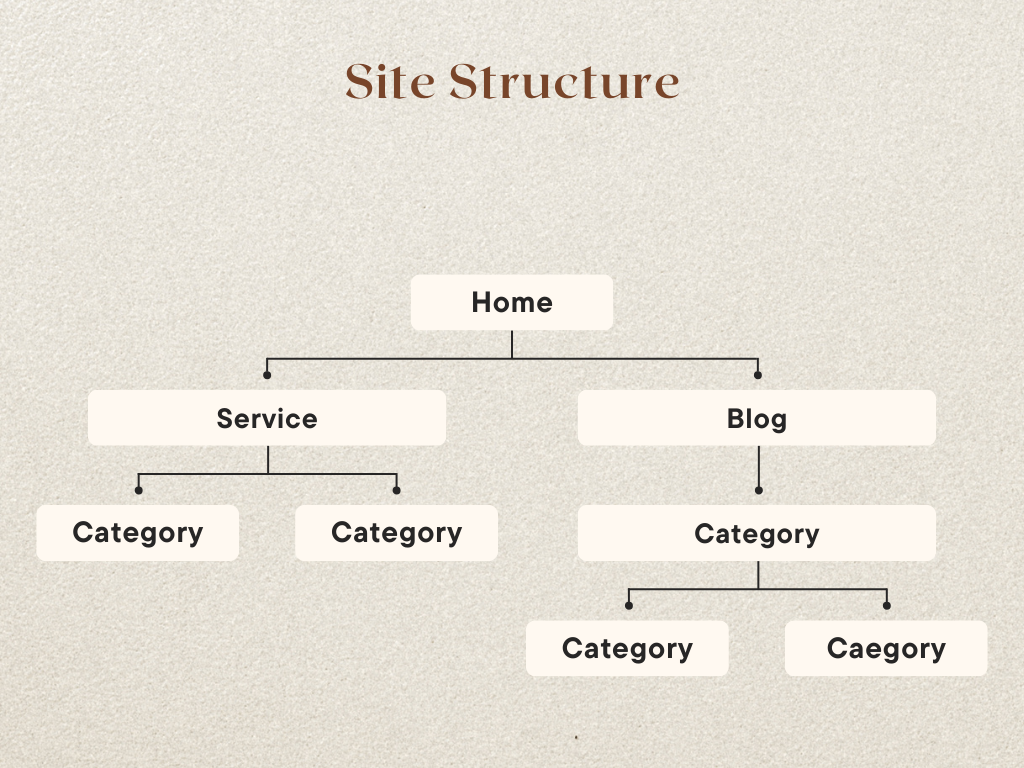
Sitemap XML:
A sitemap XML is a file that lists all the URLs of a website, along with additional metadata about each URL, such as when it was last updated and how often it changes. It helps search engines like Google crawl and index the website more efficiently by providing a roadmap of its structure and content.
If you are using WordPress website, Yoast SEO plugin automatically generate your sitemap.
Robot.txt:
Robots.txt is a text file placed on a website’s server that tells search engine crawlers which pages or files they can or cannot crawl. It’s important because it helps control how search engines access and index a website’s content.
Canonical Tag:
A canonical tag is an HTML element that tells search engines which version of a webpage is the preferred or canonical version when multiple versions of the same content exist.
It helps prevent duplicate content issues by consolidating ranking signals to the preferred version of the page.
This is important for SEO because it ensures that search engines prioritize indexing and ranking the correct version of a webpage, ultimately improving the website’s search engine visibility and avoiding potential penalties for duplicate content.
Internal linking
Internal linking involves connecting different pages within a website through clickable links. It’s vital for SEO and user experience. By linking relevant pages together, you help search engines understand your site’s structure and content.
This improves crawling, indexing, and ranking. Additionally, internal links guide users to relevant information, enhancing navigation and engagement. Strive for a clear and organized linking structure, prioritizing links from high-authority pages to others. This spreads authority and boosts visibility.
Authority
In the realm of website analysis and SEO (Search Engine Optimization), authority refers to the perceived credibility and influence of a website or web page.
There are primarily two types of authority in SEO:
Page Authority(PA):
Page Authority measures the authority of a specific page on a website. Like DA, it’s influenced by factors such as the number and quality of inbound links to the page, the relevance of the content, and the overall trustworthiness of the page.
Domain Authority(DA):
Domain Authority measures the overall authority of a website’s domain. It’s calculated based on factors such as the quantity and quality of inbound links (backlinks) pointing to the domain, the domain’s age, its popularity, and its overall trustworthiness.
Pages with higher PA scores are more likely to rank well in search engine results pages (SERPs) for relevant queries.
“Furthermore, the Moz Chrome extension offers valuable insights into website performance.”
Backlink
A backlink is a link from one website to another. Backlinks are crucial for SEO because they serve as a vote of confidence from one site to another. When a website links to your site, it signals to search engines that your content is valuable and worthy of citation.
Here is how to use and optimize backlinks for SEO:
1. Acquire Quality Links: Create valuable content, reach out to relevant sites, and guest blogs, and engage in industry communities.
2. Prioritize Quality: Focus on acquiring high-quality backlinks from authoritative and relevant websites.
3. Anchor text Optimization: When possible, optimize the anchor text of your backlinks with relevant keywords. However, avoid over-optimization and ensure that your anchor text appears natural and adds value to the content.
4. Diversification: Aim for a diverse backlink profile with a mix of different types of backlinks, including links from various domains, different types of websites (e.g., blogs, news sites, forums), and a combination of dofollow and nofollow links.
5. Monitor and Disavow: If you identify any spammy or low-quality backlinks that could harm your SEO, use Google’s Disavow Tool to ask Google to ignore those links.
SEO different approaches
When it comes to boosting your website’s visibility on search engines, there are two main approaches: black-hat SEO and white-hat SEO.
Black hat SEO involves using shady tactics to trick search engines into ranking your site higher. This includes things like copying content from other sites, hiding keywords on your page, and buying spammy backlinks. While it might give you a temporary traffic boost, it can ultimately get your site penalized or banned by Google.
On the other hand, White hat SEO focuses on following search engine guidelines and using legitimate tactics to improve your site’s ranking. This means creating original, high-quality content, optimizing your website for relevant keywords, and building genuine relationships with other websites for backlinks.
Somewhere in between lies Gray hat SEO, which isn’t as risky as black hat tactics but isn’t as pure as white hat strategies. It involves tactics like guest blogging for links, where the intent is to gain an advantage without blatantly manipulating search results.
In the end, it’s all about playing by the rules and focusing on long-term growth. While black hat SEO might offer quick wins, it’s not worth the risk of getting penalized. White hat SEO, on the other hand, ensures sustainable success and a good reputation with search engines.
E-Commerce SEO
When it comes to digital marketing, understanding the distinction between SEO and eCommerce SEO is crucial. While both share the fundamental goal of enhancing online visibility, they diverge in their focus and strategies.
SEO encompasses a broad spectrum of techniques aimed at improving a website’s visibility across search engine results pages (SERPs).
This involves optimizing various elements such as keywords, content, and technical aspects to drive organic traffic and enhance overall online presence.
On the other hand, eCommerce SEO is tailored specifically for online retail businesses. It revolves around optimizing product pages, categories, and other elements to drive sales and revenue. This includes targeting product-specific keywords, optimizing product descriptions, and enhancing the shopping experience to maximize conversions.
While SEO aims to improve website visibility and authority, eCommerce SEO prioritizes driving sales and ROI for online stores. Learned in depth about E- Commerce SEO
Google Algorithm
Google algorithm updates refer to changes made to Google’s search algorithm, which determines the ranking of websites in search results.
These updates are implemented periodically to improve the quality and relevance of search results, providing users with the most accurate and useful information in response to their queries.
The importance of SEO and Google algorithm updates lies in their impact on website visibility and traffic. Websites that rank higher in search results are more likely to attract organic traffic, resulting in increased visibility, engagement, and potential conversions.
By staying updated on Google algorithm updates and adhering to SEO best practices, website owners can ensure their sites remain optimized for search and maintain or improve their rankings over time. This, in turn, helps businesses reach their target audience effectively and achieve their online marketing goals
Google E-A-T Guidelines
I believe you’re referring to E-A-T, which stands for Expertise, Authoritativeness, and Trustworthiness. It’s a concept outlined in Google’s Search Quality Evaluator Guidelines, which are used by human quality raters to assess the quality of search results.
Here’s a brief overview of E-A-T.
Expertise: Refers to the level of knowledge and expertise demonstrated by the content creator or website author. Content should be written by individuals who have relevant expertise in the topic they’re discussing.
Authoritativeness: Relates to the perceived authority of the content creator or website within its industry or niche. Authoritative sources are trusted and respected by their audience and peers.
Trustworthiness: Refers to the reliability and credibility of the content and the website as a whole. Trustworthy sources provide accurate information, cite credible sources, and demonstrate transparency and integrity.
How to improve a website according to E-A-T
-
- Ensure content is expertly crafted by knowledgeable professionals.
-
- Earn authoritative backlinks from reputable sources.
-
- Display credentials and transparent information.
-
- Focus on high-quality, original content.
-
- Enhance user experience with easy navigation and speed.
-
- Highlight the author expertise and credentials.
-
- Provide accurate information with proper citations.
-
- Foster user engagement with compelling content.
Implementing these tips can elevate your website’s credibility and performance in search results.
You can see the latest updates and guidelines for E-A-T.
Conclusion:
I trust you found this guide insightful and valuable for your SEO journey. Remember, SEO is a marathon, not a sprint. There are no shortcuts to success. Commit to doing things the right way, consistently striving for excellence, and going the extra mile. By staying informed, implementing best practices, and continuously refining your strategies, you’ll distinguish yourself in the competitive digital landscape. Keep pushing forward with determination and perseverance, and success will follow

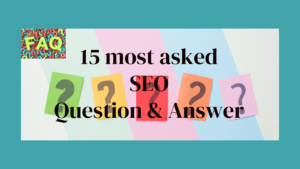
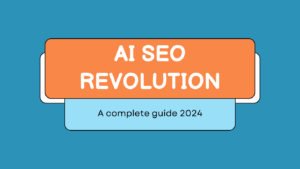

Pingback: 15 Most Asked SEO Question& Answer - Bishalkumar
Pingback: Understanding the fundamentals: Digital Marketing guide